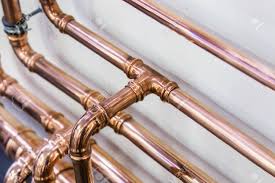
Identifying The Plumbing Pipes In Your Home
Your home’s plumbing system is made up of several different kinds of pipes. Some pipes are designed to deliver clean water, while other pipes are for removing waste water. The material used to construct the plumbing pipes in your home will vary depending on its purpose and the time frame in which your home was constructed. Throughout the decades, different materials have been used to craft plumbing pipes. So, the material used to construct the plumbing pipes in you home will depend when your home was built.
Copper Pipes
Copper is one of the most common materials used to make plumbing pipes. These pipes are mostly used for potable water. Copper is an excellent material for plumbing pipes because it is less prone to corrosion, durable, less likely to leak, is heat resistant, has a long lifespan, and does not pollute the water that runs through it. The use of copper in plumbing dates all the way back to the Egyptians. However, it didn’t become widely used in recent times until the 1940’s. 
Galvanized Steel
The plumbing pipes in your home may be made of galvanized steel if your home was built before the 1960’s. Galvanized steel pipes are steel pipes that are dipped in a zinc coating. This coating helps protect the pipe from corrosion. Galvanized steel was used because it was strong, durable, and provided a good alternative to lead. However, the downside of galvanized steel is that it is heavy and can rust from the inside. Homes with older plumbing, may be suffering from low water pressure, frequent clogs, and corrosion. In which case, it may be time to replace your galvanized steel pipes or look into pipelining. The method of treatment will depend on the condition of your pipes.
Cast Iron
Cast iron was most commonly used in sewer pipes. However, some water supply lines were also constructed out of cast iron. Cast iron was widely used in plumbing from the 17th to the 20th century, and was even used in the construction of the fountains of Versailles. It was widely used because of its longevity and its ability to withstand heavy usage and high pressure. Pipes that are made out of cast iron typically last 80-100 years, before they corrode from the inside out. When a cast iron pipe fails, it is usually due to corrosion. Some chemical drain cleaners can exacerbate corrosion, so they should be avoided if you have cast iron sewer pipes. 
PVC Pipes
PVC, short for polyvinyl chloride, is commonly used in a lot of plumbing today. The plastic pipes you are probably familiar with are probably made out of PVC. PVC is an inexpensive material that is easy to work with,light weight, won’t corrode, and lasts a long time. PVC pipes are used for both potable water and sewer lines. The size and thickness of the pipe depends on its purpose. One downside of PVC pipes, is that extremely hot water can cause damage.
CPVC Pipes
CPVC pipes are pvc pipes that contain a chlorine element. They are mostly used for potable drinking water. CPVC pipes have a higher temperature threshold, so they can be used with hot water.
PEX Pipes
PEX pipes are another common pipe that are used for water supply lines. They are inexpensive, easy to work with, light weight, don’t corrode, don’t leak, and can handle hot water. However, they cannot be used outdoors as they are susceptible to the elements.  When it comes to the plumbing pipes in your home it is a good idea to be familiar with what you have. If you have older plumbing, having a plumbing inspection is a good idea. This can help you ascertain the condition of your plumbing and prevent future plumbing problems. To learn more about the plumbing pipes in your home or to schedule a plumbing inspection contact Rooter Hero today.
When it comes to the plumbing pipes in your home it is a good idea to be familiar with what you have. If you have older plumbing, having a plumbing inspection is a good idea. This can help you ascertain the condition of your plumbing and prevent future plumbing problems. To learn more about the plumbing pipes in your home or to schedule a plumbing inspection contact Rooter Hero today.
Related Articles Hammer Time – What Is Water Hammer? What You Need To Know Before Your Bathroom Remodel Myth Busters – Common Plumbing Myths You Might Believe







